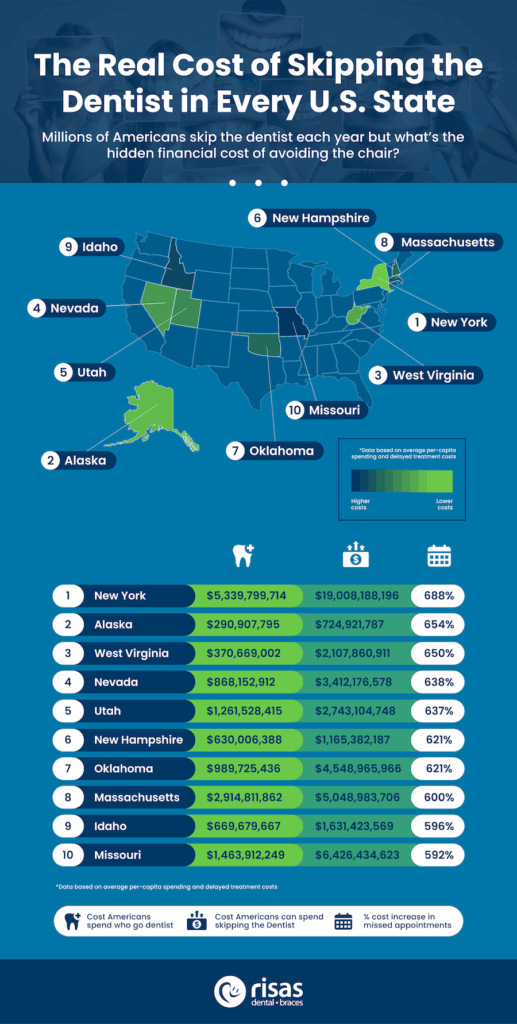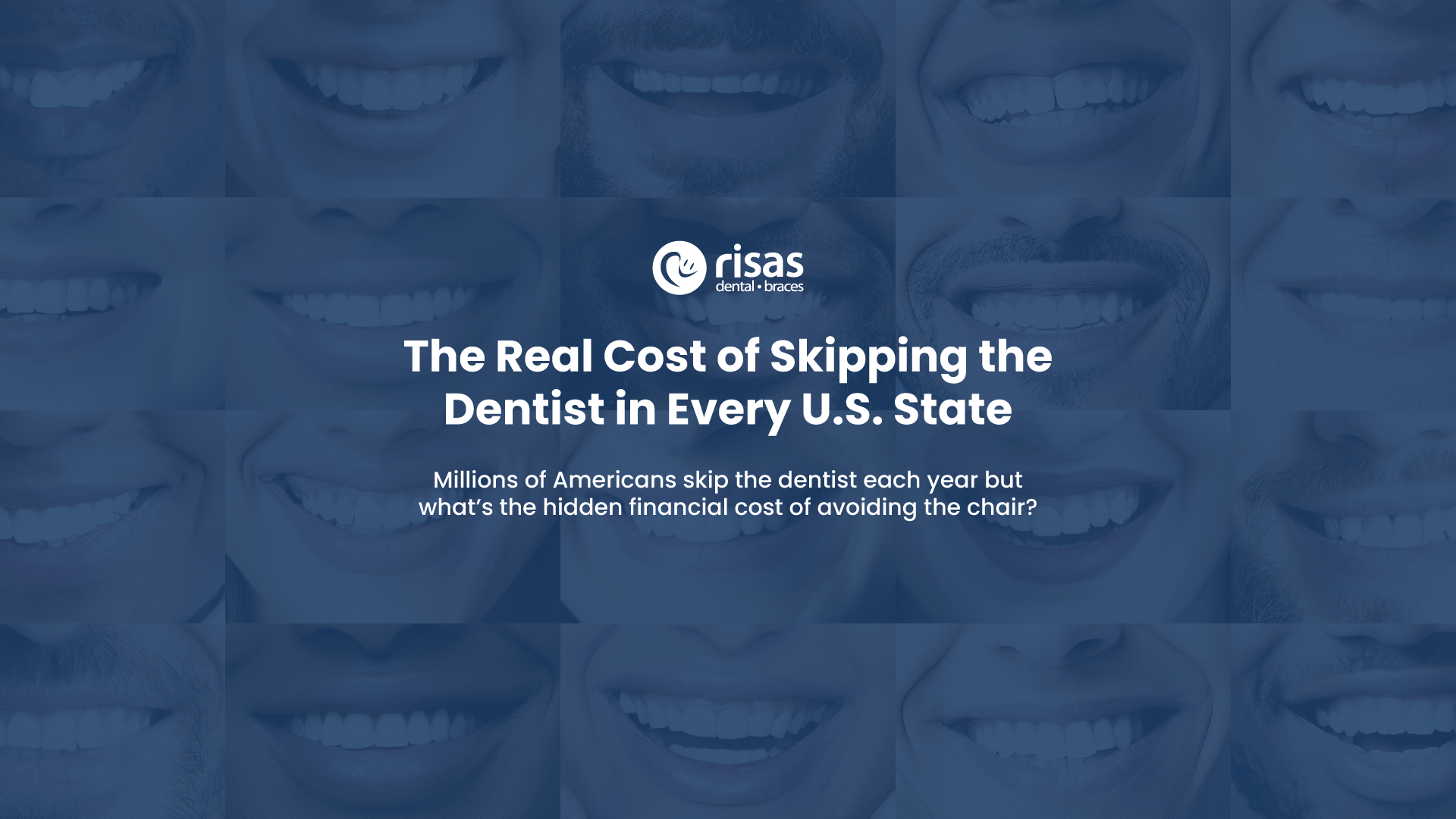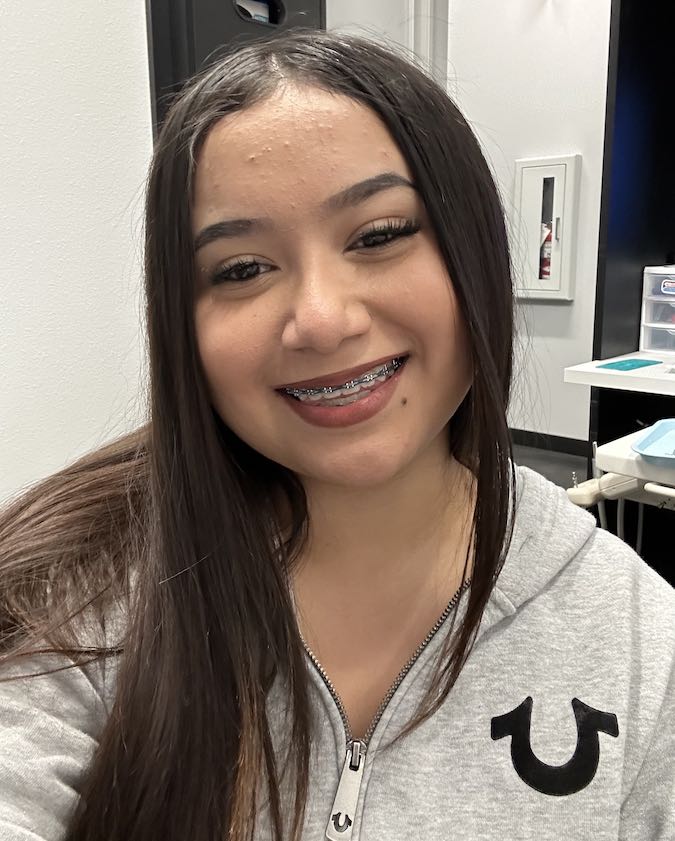Is dental insurance worth it? The real costs of skipping the dentist
It's easy to find excuses not to go to your dental check-ups, especially when you’re worried about how you’re going to pay the check. If that’s you, you’re not alone – the 2025 Dental Report found that around 1 in 3 American adults have avoided a dental appointment in the last year, an unfortunate trend consistent with the findings over the past decade.
But with so many demands on our money every month, is dental insurance actually worth it? At Risas Dental and Braces, we’ve been investigating how much the average American adult is spending on dental care and what you risk spending on treatment in the long term when you skip routine visits.
Do I really need dental insurance?
The Dental Report found that, across the US, an estimated 34.1% of adults had skipped dental visits over the past year. That means one in three Americans didn’t see a dentist for routine check-ups - and the number one reason given for missing appointments is the prohibitive costs due to lack of access to dental insurance.
We get it; dental insurance can be expensive, and if you’ve never had any major issues with your teeth, it might feel like you can do without it, especially if your finances are stretched thin. But the longer you leave an untreated cavity or annoying toothache, the higher your chances of needing a root canal, crown or full tooth extraction, which means greater risk of dental complications and a much steeper bill to pay to get it fixed.
If you’re not sure whether dental insurance is worth it for you, consider if you could afford to look after your oral health if something did go wrong.
Highest cost increase for delayed treatment by state
At Risas Dental and Braces, we’ve carried out our own investigative research into how much the average American adult who regularly visits the dentist spends on dental care, versus how much they might spend if they skip the routine visits and avoid preventative dental care, to see if dental insurance is worth it.

For each state, we looked at the:
- Annual dental spend of the average American adult who visits the dentist regularly
- Potential annual cost to treat oral health issues that often arise from lack of preventative care
- Percentage increase in overall costs for those who don’t visit the dentist regularly
Based on our research, we’ve identified the top five states where, if you don’t visit the dentist regularly, you’ll be shelling out the biggest increase in costs.
- Utah
Coming in at number five, the average spend on services for those regularly attending the dentist in Utah is $360 per capita. But when minor issues aren’t caught early, the cost of the delayed treatments comes out at $2,728 – this means that without preventative care, your costs could increase by 637%.
- Nevada
Next on the list is Nevada, with the average adult spending $361, compared with delayed treatment costs of $2,664, increasing your costs by 638%. Don’t forget, if you’re based in Nevada and looking for a compassionate, expert Las Vegas dentist with flexible payment options available to help you manage your finances, you can find two of our locations in North Las Vegas and Boulder Crossings.
- West Virginia
Those in West Virgina are paying the third-highest rates in the country for delayed dental treatments, averaging out at $2,744. While Wisconsin and Wyoming may both have higher costs associated with delayed treatment, individual patients in West Virginia can access much cheaper regular dental treatments at just $366, putting the increase in spend at an eye-watering 650%.
- Alaska
Alaska comes in with the one of the cheapest per capita spends on regular dental care in the country at just $340. So, while the cost of delayed treatment is similarly low - $2,564 – the percentage increase is stark at 654%.
- New York
With a low per-capita spend of $340, the cost of delayed treatment in New York averages out at $2,680, meaning those living in New York state who don’t visit the dentist for check-ups and critical preventative care risk spending an eye-watering 688% more on their dental health than those who do. Across the state, that comes in at over $19 million spent on delayed treatments per year!
Should I get dental insurance?
We spoke to Dr. Collin Bowerman to see what they made of our findings.
“Preventative dental care is the number one way to reduce your dental costs in the long run. Think about this – a minor problem, like filling a cavity, might cost you $100 to get fixed. If you ignore it, it won’t go away, and suddenly you could be facing treatments costing $1,000 or more.
“For those with access to it, we would highly recommend investing in dental insurance or a dental savings plan, so you can sidestep major health concerns and protect both your finances and your long-term health. Dental insurance typically covers those routine visits to the dentist, so all you have to do is show up. If you’re not able to invest in dental insurance, many practices – including here at Risas Dental and Braces – offer a variety of payment plans and affordable options to help alleviate your dental care costs.
“We appreciate that many families across America, for various reasons, can’t access dental insurance. Whatever your financial situation, the best thing you can do for your oral health is to come to the dentist as often as possible.”
To learn more about the different options available to you with Risas Dental and Braces – including 20% off treatments paid in full, a healthcare credit card or a personalized payment plan – please take a look at our payment options. We also offer memberships for individuals, two people or families of up to eight, providing a low-cost alternative to insurance regardless of your income or credit score.
Top tips to keep your dental spending down
Our experts have put together some ideas for how you can look after your own dental health and access any support that might be available to you.
- Stick to a good daily routine by brushing twice daily and flossing. This helps remove plaque, prevent cavities, and keep your gums healthy. Consistency is key to long-term oral health.
- Keep up with regular check-ups. Visit your dentist at least twice a year for cleanings and exams, even if you’re not experiencing any issues. Regular visits help catch potential problems early and keep your smile in top shape.
- Choose preventive treatments to protect your teeth and reduce the need for more complex treatment down the line.
Remember, no matter how long it’s been since your last visit to the dentist or what shape your teeth are in, our expert team is on-hand to provide personalized oral health care and guidance for you and your family. If you’ve not been to the dentist in a while, we have a video on what to expect and other helpful information on our blog.
Book an appointment now or search our locations with your zip code to see if we have a clinic near you.

